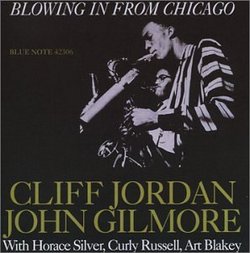| All Artists: Clifford Jordan, John Gilmore Title: Blowing in From Chicago Members Wishing: 3 Total Copies: 0 Label: Blue Note Records Release Date: 1/28/2003 Album Type: Original recording reissued, Original recording remastered Genres: Jazz, Pop, Rock Styles: Modern Postbebop, Bebop Number of Discs: 1 SwapaCD Credits: 1 UPCs: 724354230622, 0724354230653, 4988006864306 |
Search - Clifford Jordan, John Gilmore :: Blowing in From Chicago
 | Clifford Jordan, John Gilmore Blowing in From Chicago Genres: Jazz, Pop, Rock
|
Larger Image |
CD Details |
CD ReviewsA lesser known "Blowing Session" G. Schramke | Vienna, Austria | 01/31/2003 (5 out of 5 stars) "It didn't happen often on BlueNote recording sessions, that two or more players of the same instrument met together in the studio. The most famous encounter maybe was Johnny Griffin together with Coltrane and Hank Mobley, an earlier thing was the two-trumpet session with Fats Navarro and Howard McGhee. In any case, these always were "friendly meetings", there was no intention to repeat the idea of "horn battles", which became famous at "Jazz at the Philharmonic". Even if this album isn't as "ferocious" as Griffin's "Blowing Session", it's nevertheless a very nice thing. I remember first owning recordings of both dates on a 2-LP set, those BlueNote LA-reissues that were widely available in the late 70's when I was still almost a kid (though recorded a month earlier than Griffin's date, it was placed second on that double-LP). First I payed more attention to Griffin, but the I "discoverded" this date. Comparing the two tenorists, I'd say it is Clifford Jordan, who dominates the session. He's got a bigger sound and composed most of the material. "Status Quo" is a beautiful tune based on "There will never be another you", "Bo-Till" has a latin-based theme, "Blue Lights"(written by Gigi Grice) and "Evil Eye" are two examples of that comfortable medium-tempo blues in f-minor, frequently used on Hard-Bop jams, and "Everywhere" is a beautiful, forgotten Horace Silver tune. I still listen to this record on occasions when I decide to listen to Griffin's "Blowing Session" (also available on RVG-Series), want to invite you to do the same." Best of the Tenor Match-ups Todd M. Stellhorn | baltimore, MD | 08/02/2007 (5 out of 5 stars) "When you think of the great tenor face-offs you might remember Johnny Griffin's "a blowing session" (with John Coltrane and Hank Mobley), Sonny Rollins' "sonny side-up" (with Sonny Stitt), "tenor conclave" (with virtually everybody), Booker Ervin's "setting the pace" (with Dexter Gordon), Sonny Stitt and Gene Ammons in the "boss tenors" series, and so on. However despite the merits of some of these other albums (ranging from the classic, "sonny side-up" to the god-awful, "tenor conclave") Clifford Jordan and John Gilmore take the top prize with "Blowing in from Chicago". I think partly the reason for this is having two of the same instruments on the same date presents some inherent problems, such as who is who, lack of texture, repetativeness, etc., however these problems are largely circumvented since the two tones, not to mention pace and style, of Clifford Jordan and John Gilmore are so intriguingly different. Indeed it almost sounds like two different instruments given the way these players approach their tenors. Gilmore is the much more agile, adventurous, and direct of the two, while Jordan takes the low road, is mesmerizing in a more melody-centered sort of way, and doesn't try to over extent himself, which is probably a smart move on his part. And while Jordan went on to do some nice things through out his career ("spellbound", "cliff-craft", and "the highest mountain", to name a few), Gilmore was stuck, I suppose happily so, under the seemingly (according to the liner notes) tyrranical grasp of Sun Ra. In anycase this is a great match-up of two very different tenor players who are nevertheless connected in their skill and sheer blowing abilities. This is a very alive album, one that pulses with blues fueled energy. I can't imagine "blowing in from chicago" boring anybody. If it does you might want someone to check your pulse, you're probably already dead. " The sixth man. Samuel Chell | Kenosha,, WI United States | 09/11/2007 (3 out of 5 stars) "Despite the comparatively few recordings by both players, the sound of this session is all too familiar, at least to these ears. If you have, say, "Art Blakey: Night at Birdland, Volumes 1 and 2," you might think that Clifford Brown and Lou Donaldson had simply left the bandstand to be replaced by two young tenor players from Chicago with the "house rhythm section" of Blakey, Silver and Russell staying around to back them up. The opening tune is even the same--"There Will Never Be Another You" in Eb (retitled "Split Kick" on the Birdland date and "Status Quo" on the present session).
The sonic similarity is only partly due to the personnel. Give recording engineer Van Gelder at least half of the credit. As exciting as these Blue Note sessions were when I started collecting them as LPs in college, they're increasingly wearing out their welcome, sounding ever more grating. Even hearing Gilmore with Sun Ra wears better on a consistent basis because the audio reproduction "documents" rather than constructs the sound. And as for the richly expressive Cliff Jordan, recordings like "Glass Bead Games" and "Live at Ethel's" are the reason these Blue Note sessions are sounding increasingly redundant. To each his own. Van Gelder has his sound, and most listeners love it. Having heard all of these guys live (with the exception of Curly Russell), I can only say that this isn't the way they sounded. (A disagreement already. Someone obviously objected because "my own" wasn't the same as "his own." Write your own review. I promise I will respect your opinion, and even reward it if the piece is written with fairness and sincerity.)" |

 Track Listings (7) - Disc #1
Track Listings (7) - Disc #1